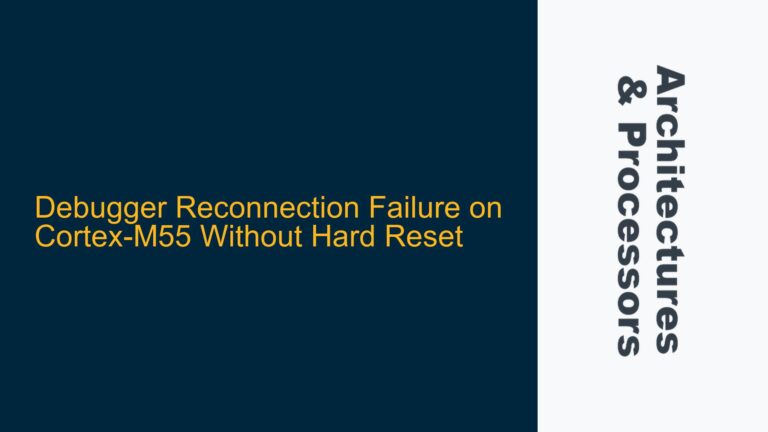AXI Protocol Peripheral Attribute Execution Order Ambiguity
The Advanced eXtensible Interface (AXI) protocol is a widely adopted on-chip communication standard for high-performance embedded systems, particularly in ARM-based architectures. One of the critical aspects of the AXI protocol is its handling of transaction ordering, which ensures data consistency and predictable behavior across different system components. However, the protocol’s treatment of peripheral regions introduces a layer of complexity that can lead to ambiguity in execution order, especially when dealing with Device Writes (DW) to peripherals.
In the AXI protocol, transactions to memory regions are strictly ordered to maintain data integrity. Specifically, the protocol mandates that a write W1 must be ordered before a write W2 if both share the same ID and target the same memory location, and W2 is received after W1. This strict ordering is crucial for memory coherence and is well-defined in the protocol. However, when it comes to peripheral regions, the protocol’s guarantees are less stringent. According to section A6.3.4 of the AXI protocol, a Device Write DW1 is guaranteed to arrive at the destination before Device Write DW2 if DW2 is issued after DW1 and both target the same peripheral region. This guarantee ensures that the order of arrival at the peripheral is consistent with the order of issuance.
However, section A6.3.5 introduces a caveat: for peripheral locations, the execution order of transactions is implementation-defined. While the protocol typically expects the execution order to match the arrival order, it does not mandate this behavior. This means that a peripheral could, in theory, execute transactions out of order, even if they arrive in the correct sequence. This ambiguity raises important questions about the predictability of peripheral behavior and the potential for subtle bugs in system designs that rely on strict ordering of peripheral transactions.
The core issue lies in the distinction between arrival order and execution order. While the AXI protocol guarantees that transactions will arrive at the peripheral in the order they were issued (when using the same AxID), it does not enforce any constraints on how the peripheral processes these transactions. This can lead to scenarios where two Device Writes, DW1 and DW2, targeting the same peripheral region with the same ID, are executed out of order by the peripheral, despite arriving in the correct sequence. Such behavior is protocol-compliant but can have significant implications for system design, particularly in cases where the order of peripheral operations is critical.
Peripheral Attribute Configuration and Transaction Reordering Risks
The potential for out-of-order execution in peripherals configured with the Peripheral attribute stems from several factors, including the nature of peripheral devices, the implementation-specific behavior allowed by the AXI protocol, and the lack of strict ordering guarantees for peripheral transactions. Understanding these factors is essential for diagnosing and mitigating risks associated with transaction reordering.
Peripheral devices, unlike memory regions, often have unique characteristics that influence how they handle transactions. For example, peripherals may have internal buffers, queues, or state machines that process incoming transactions independently of their arrival order. Additionally, peripherals may prioritize certain types of transactions over others, leading to reordering. The AXI protocol’s allowance for implementation-defined execution order accommodates these variations but also introduces the risk of unexpected behavior.
The use of the same AxID for multiple transactions targeting the same peripheral region further complicates the issue. While the AXI protocol guarantees that transactions with the same AxID will arrive in the order they were issued, it does not enforce any constraints on how the peripheral processes these transactions. This means that a peripheral could choose to execute DW2 before DW1, even if DW1 arrived first. Such reordering can occur due to various factors, including peripheral-specific optimizations, internal buffering mechanisms, or prioritization schemes.
Another contributing factor is the lack of strict ordering guarantees for peripheral transactions in the AXI protocol. Unlike memory transactions, which are subject to strict ordering rules, peripheral transactions are treated more flexibly. This flexibility allows for optimizations and customizations in peripheral design but also introduces the potential for reordering. For example, a peripheral might implement a round-robin scheduling algorithm that processes transactions in a different order than they arrived, leading to out-of-order execution.
The risks associated with transaction reordering are particularly pronounced in systems where the order of peripheral operations is critical. For instance, in a system where a sequence of Device Writes configures a peripheral’s registers, out-of-order execution could result in incorrect configuration and unpredictable behavior. Similarly, in systems where peripherals interact with other components, such as DMA controllers or interrupt handlers, reordering could lead to race conditions, data corruption, or other subtle bugs.
Ensuring Predictable Peripheral Transaction Execution
To address the risks associated with out-of-order execution of peripheral transactions, system designers must adopt strategies that ensure predictable behavior while remaining compliant with the AXI protocol. These strategies include careful peripheral design, the use of synchronization mechanisms, and adherence to best practices for transaction ordering.
One approach to ensuring predictable execution is to design peripherals with explicit ordering constraints. By implementing internal mechanisms that enforce the order of transaction execution, peripherals can avoid reordering and maintain consistency with the arrival order. For example, a peripheral could use a first-in-first-out (FIFO) buffer to process transactions in the order they arrive, ensuring that DW1 is executed before DW2 if it arrived first. While this approach requires additional design effort, it can significantly reduce the risk of reordering-related issues.
Another strategy is to use synchronization mechanisms, such as barriers or semaphores, to enforce ordering at the software level. By inserting synchronization points between critical transactions, software can ensure that previous transactions have completed before proceeding with subsequent ones. For example, after issuing DW1, software could wait for an acknowledgment or status update from the peripheral before issuing DW2. This approach leverages the AXI protocol’s guarantee that transactions will arrive in order, while adding an additional layer of control over execution order.
In cases where strict ordering is essential, system designers can also consider using multiple AxIDs to differentiate between transactions that require ordered execution and those that do not. By assigning unique AxIDs to critical transactions, designers can ensure that they are processed in the correct order, while allowing other transactions to be reordered as needed. This approach balances the need for predictability with the flexibility allowed by the AXI protocol.
Finally, adherence to best practices for transaction ordering can help mitigate the risks associated with reordering. For example, designers should avoid relying on implicit ordering assumptions and instead use explicit mechanisms to enforce order where necessary. Additionally, thorough testing and validation of peripheral behavior can help identify and address potential reordering issues before they impact system performance or reliability.
In conclusion, while the AXI protocol’s treatment of peripheral transactions introduces the potential for out-of-order execution, careful design and implementation strategies can ensure predictable behavior. By understanding the protocol’s guarantees and limitations, and by adopting appropriate mitigation techniques, system designers can effectively manage the risks associated with transaction reordering and build robust, reliable systems.






